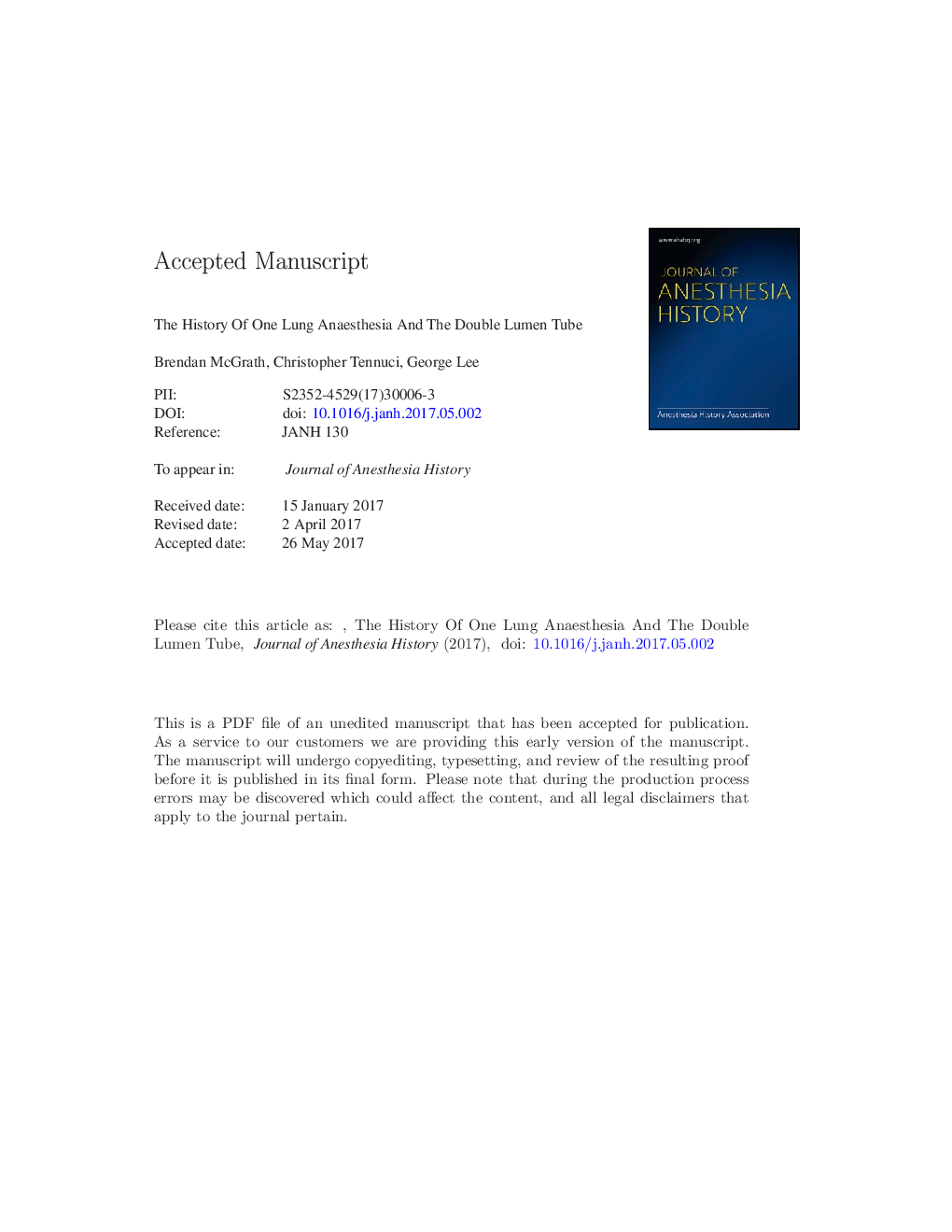| کد مقاله | کد نشریه | سال انتشار | مقاله انگلیسی | نسخه تمام متن |
|---|---|---|---|---|
| 7518102 | 1486778 | 2017 | 57 صفحه PDF | دانلود رایگان |
عنوان انگلیسی مقاله ISI
The History of One-Lung Anesthesia and the Double-Lumen Tube
ترجمه فارسی عنوان
تاریخ بیهوشی یک ریه و لوله دو لومن
دانلود مقاله + سفارش ترجمه
دانلود مقاله ISI انگلیسی
رایگان برای ایرانیان
کلمات کلیدی
تهویه یک ریه، لوله دو طرفه آندوبرنشیل، تهویه ریه
ترجمه چکیده
بیهوشی ریه یک چالش عملی، آناتومیک و فیزیولوژیک را در بطن امروز به بیهوشی ارائه می دهد. تکنیک ها و تجهیزاتی که امروزه استفاده می کنیم، به آرامی در طول قرن گذشته پیشرفت کرده اند. ایده تهویه ریه جدا شده از مطالعات برونکوسپیرومتری توسط فیزیولوژیست پیشرو در سال 1871 بود و برخی از تجهیزات اصلی آن برای استفاده بالینی در دهه 1930 اقتباس شده بود. تکنیک های بیهوشی به طور کلی برای پیشبرد پیشرفت های جراحی توسعه داده شده است و توسعه لوله های دوبلور بدون استثناء است. توسعه لوله دو لومن به صورت پراکنده بود و عمدتا به روش های پیچیده تر قفسه سینه کمک می کرد، که عمدتا با بیماری های ریوی ناگهانی همراه بود. هنگامی که نیاز به تهویه مستقل از ریه ها در عمل بالینی شناسایی شد، پیشگامان این روش روش های خود و اغلب تجهیزات خود را توسعه دادند. این منجر به توانایی انسانی برای کنترل تهویه به هر ریه شد، از جمله فروپاشی ریه عملیاتی و حفاظت از ریه های جدا شده در برابر آلودگی. همانطور که این بیهوشی ها قابل اطمینان بود، محوطه جراحی بیهوشی ریه شروع به گسترش کرد و امروزه تهویه یک ریه برای ارتقاء عمل جراحی قفسه سینه، عمدتا بر روی ریه، بلکه دیواره رحم، دیواره قفسه سینه و روش های جراحی مدیاستین نیز مورد استفاده قرار می گیرد.
موضوعات مرتبط
علوم پزشکی و سلامت
پزشکی و دندانپزشکی
بیهوشی و پزشکی درد
چکیده انگلیسی
One-lung anesthesia presents many practical, anatomical, and physiological challenges to the anesthetist in modern day practice. The techniques and equipment that we use today have developed slowly over the course of the last century. The idea of isolated lung ventilation came from bronchospirometry studies by pioneering physiologists as early as 1871, and some of their original equipment was adapted for clinical use in the 1930s. Anesthetic techniques have generally been developed to facilitate surgical advances, and the development of double-lumen tubes is no exception. The development of the double-lumen tube was sporadic and occurred mainly to allow more complex thoracic procedures, mostly associated with suppurative lung disease. Once the need for independent ventilation of the lungs was identified in clinical practice, pioneers of the technique developed their own methods and often their own equipment. This led to the ability of the anesthetist to be able to control ventilation to each lung, including collapse of the operative lung and protection of the isolated lung against contamination. As these anesthetics became more reliable, the surgical scope for one-lung anesthesia began to broaden, and today one-lung ventilation is used to facilitate thoracic surgery, mainly on the lung, but also esophageal, thoracic wall, and mediastinal surgical procedures.
ناشر
Database: Elsevier - ScienceDirect (ساینس دایرکت)
Journal: Journal of Anesthesia History - Volume 3, Issue 3, July 2017, Pages 76-86
Journal: Journal of Anesthesia History - Volume 3, Issue 3, July 2017, Pages 76-86
نویسندگان
Brendan McGrath, Christopher Tennuci, George Lee,
